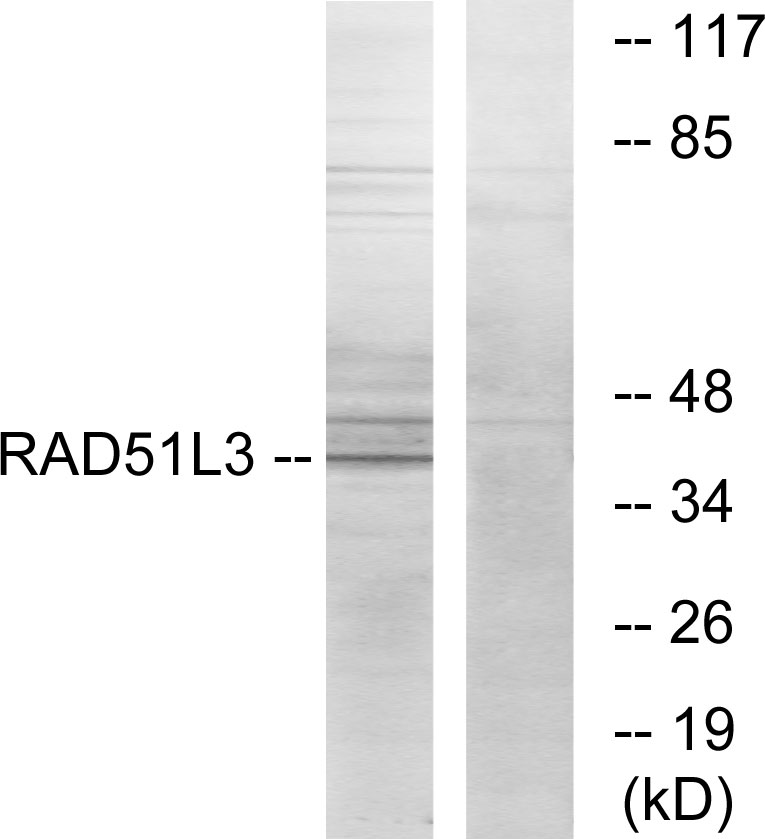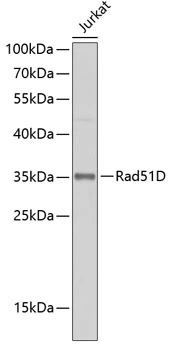![ICC/IF analysis of HeLa cells using GTX23638 Rad51D antibody [5B3/6]. Green : primary antibody Red : Tubulin Blue : DAPI ICC/IF analysis of HeLa cells using GTX23638 Rad51D antibody [5B3/6]. Green : primary antibody Red : Tubulin Blue : DAPI](https://www.genetex.com/upload/website/prouct_img/normal/GTX23638/GTX23638_156_ICC-IF_w_23060722_396.webp)
ICC/IF analysis of HeLa cells using GTX23638 Rad51D antibody [5B3/6]. Green : primary antibody Red : Tubulin Blue : DAPI
Rad51D antibody [5B3/6]
GTX23638
ApplicationsImmunoFluorescence, Western Blot, ImmunoCytoChemistry
Product group Antibodies
ReactivityHuman
TargetRAD51D
Overview
- SupplierGeneTex
- Product NameRad51D antibody [5B3/6]
- Delivery Days Customer9
- Application Supplier NoteWB: 1:1000. ICC/IF: 1:100 - 1:500. *Optimal dilutions/concentrations should be determined by the researcher.Not tested in other applications.
- ApplicationsImmunoFluorescence, Western Blot, ImmunoCytoChemistry
- CertificationResearch Use Only
- ClonalityMonoclonal
- Clone ID5B3/6
- ConjugateUnconjugated
- Gene ID5892
- Target nameRAD51D
- Target descriptionRAD51 paralog D
- Target synonymsBROVCA4, R51H3, RAD51L3, TRAD, DNA repair protein RAD51 homolog 4, RAD51 homolog D, RAD51-like protein 3, recombination repair protein
- HostMouse
- IsotypeIgG1
- Protein IDO75771
- Protein NameDNA repair protein RAD51 homolog 4
- Scientific DescriptionThe protein encoded by this gene is a member of the RAD51 protein family. RAD51 family members are highly similar to bacterial RecA and Saccharomyces cerevisiae Rad51, which are known to be involved in the homologous recombination and repair of DNA. This protein forms a complex with several other members of the RAD51 family, including RAD51L1, RAD51L2, and XRCC2. The protein complex formed with this protein has been shown to catalyze homologous pairing between single- and double-stranded DNA, and is thought to play a role in the early stage of recombinational repair of DNA. Several alternatively spliced transcript variants of this gene have been described, but the biological validity of some of them has not been determined. [provided by RefSeq]
- ReactivityHuman
- Storage Instruction2°C to 8°C
- UNSPSC12352203
References
- Fang P, Madden JA, Neums L, et al. Olaparib-induced Adaptive Response Is Disrupted by FOXM1 Targeting that Enhances Sensitivity to PARP Inhibition. Mol Cancer Res. 2018,16(6):961-973. doi: 10.1158/1541-7786.MCR-17-0607Read this paper






